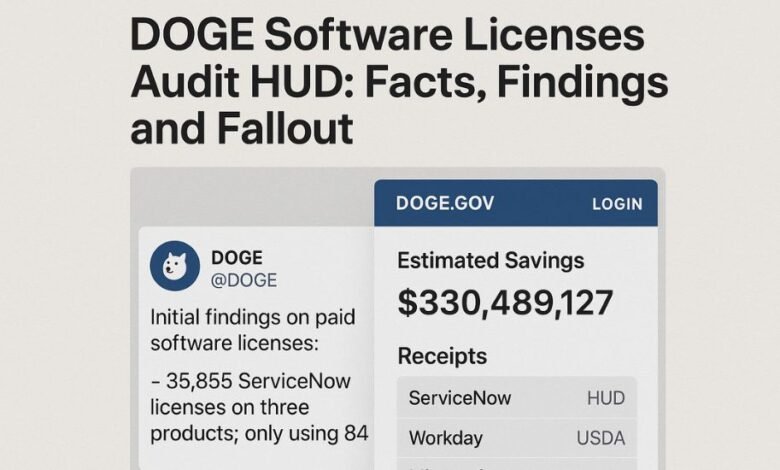DOGE Software Licenses Audit HUD: Facts, Findings, and Fallout

In early 2025, the Department of Government Efficiency (DOGE) — a newly formed government entity tasked with improving fiscal accountability — made headlines for its ambitious audits into federal software licensing. Among the most talked-about reports was its HUD (Department of Housing and Urban Development) software licenses audit, which quickly went viral on social platforms and sparked heated debate across political and tech circles.
At the center of the storm was a series of posts from DOGE’s official X (formerly Twitter) account, claiming that HUD was paying for tens of thousands of unused software licenses from major vendors such as ServiceNow, Workday, and Microsoft. These findings were presented as proof of “massive government waste,” accompanied by a detailed “receipts portal” on DOGE.gov, which listed alleged savings totaling hundreds of millions of dollars.
But as the story unfolded, so did questions about accuracy, methodology, and transparency. What began as an explosive claim of government inefficiency gradually turned into a broader conversation about data integrity, digital procurement, and political narratives.
DOGE’s Mission and the Birth of the Audit
The Department of Government Efficiency (DOGE) was established to identify wasteful spending and recommend cost-cutting measures across federal departments. With its modern branding, aggressive communication style, and tech-centric approach, DOGE quickly became both a symbol of reform and controversy.
In February 2025, DOGE published its first major report — an audit into software licenses across several agencies, including HUD. The headline number caught everyone’s attention:
“35,855 ServiceNow licenses purchased, only 84 in use.”
DOGE claimed these numbers came directly from internal IT procurement data, suggesting that HUD was paying for massive amounts of unused or duplicate licenses, costing taxpayers millions annually. The same audit also flagged potential overlaps in Workday HR software and Microsoft 365 contracts, citing “inefficient license allocations” and “mismanaged renewals.”
The DOGE report estimated that correcting these inefficiencies could save more than $330 million. These findings were immediately posted to X and the DOGE website under a “Transparency Receipts” section.
How DOGE’s Audit Process Worked
According to official statements, the DOGE audit process relied on a mix of automated license scans, agency-supplied contract data, and federal procurement databases. The department’s goal was to identify redundant or unused licenses, especially those automatically renewed through vendor subscriptions.
DOGE said its process involved:
-
Collecting vendor invoices for the past 3–5 years.
-
Comparing license counts against active user logs.
-
Flagging any large gaps between purchased and active licenses.
-
Publishing “receipts” for public review.
However, as analysts and journalists began reviewing the data, it became clear that the audit may not have accounted for complex licensing structures — such as shared enterprise agreements, development environments, or test accounts. In other words, not every “unused” license was actually waste.
The Controversy: Errors and Deletions
Within weeks of publication, media outlets and watchdogs noticed discrepancies in DOGE’s numbers. Investigations by The Guardian, Politico, and Wired revealed that several “receipts” on the DOGE portal were inaccurate or duplicated.
For instance:
-
Some licenses counted as “unused” were actually part of agency-wide enterprise bundles, which require pre-purchased capacity for scaling.
-
A few contracts were listed multiple times, inflating apparent waste.
-
In certain cases, DOGE misinterpreted vendor reporting formats, leading to exaggerated figures.
After these reports surfaced, several of the largest line items were quietly removed or edited from the DOGE.gov receipts page. DOGE claimed the changes were “routine data updates,” but critics argued they were attempts to walk back inflated claims.
HUD’s Response to DOGE’s Claims
HUD officials responded cautiously but firmly, emphasizing that DOGE’s report “misrepresented the complexity of enterprise software licensing.” According to HUD’s IT Procurement Office, many of the flagged licenses were:
-
Reserved for future onboarding or project expansions.
-
Bundled under multi-year contracts that could not be instantly reduced.
-
Required for compliance or audit reasons, even if inactive at a given moment.
In a public statement, HUD clarified that its ServiceNow licenses were “appropriately allocated under enterprise agreements that support long-term IT modernization.” The agency also pointed out that DOGE had not conducted any formal interviews or data reconciliations with HUD procurement teams before publishing its findings.
This highlighted a growing tension between DOGE’s political push for transparency and agencies’ practical realities of digital infrastructure management.
The Role of Social Media and DOGE’s Viral Strategy
One of the reasons the DOGE audit gained so much attention was its social media-driven communication strategy. DOGE frequently posted infographics, memes, and dramatic “before and after” savings charts, which resonated with the public’s frustration toward government inefficiency.
However, this same approach also fueled skepticism. Experts argued that complex fiscal audits were being oversimplified for social media virality, risking misinformation.
A Reddit discussion thread titled “DOGE Receipts: Are These Numbers Real?” gained thousands of comments, with IT professionals dissecting the technical details of software licensing. Many agreed that while government waste exists, the way DOGE framed its data was misleadingly simplistic.
The Technical Problem: Counting Licenses Isn’t Simple
To understand why DOGE’s numbers were controversial, it’s important to grasp how software licensing works in large organizations.
Federal agencies like HUD often purchase:
-
Enterprise-wide licenses that allow any employee access within a usage pool.
-
Development or testing licenses that support backend functions.
-
Inactive but billable seats under compliance or data-retention policies.
These arrangements make it nearly impossible to measure “unused” licenses with simple math. Without access to vendor dashboards, renewal terms, or user behavior analytics, even an automated audit can produce misleading conclusions.
As one analyst told Wired,
“Counting unused licenses in a federal agency is like counting parked cars and assuming no one drives.”
This analogy encapsulated the challenge DOGE faced — and why its critics argued that the department prioritized publicity over precision.
Political Context and Public Reaction
DOGE’s audit didn’t exist in a vacuum. It became a flashpoint in ongoing debates about federal spending, transparency, and political reform. Supporters praised the department for exposing potential inefficiencies, while detractors accused it of weaponizing partial data to score political points.
Public reaction was polarized:
-
Supporters on X hailed DOGE as “the watchdog government needs.”
-
Critics on Reddit and Facebook argued the audit was “an unverified publicity stunt.”
-
Tech insiders warned that oversimplified audits could damage vendor relations and contract negotiations.
Even within government circles, some agencies quietly expressed frustration, noting that DOGE’s aggressive tactics risked disrupting ongoing IT modernization projects.
DOGE.gov and the “Receipts” Portal
One of DOGE’s hallmark innovations was the DOGE.gov Receipts Portal, a public-facing dashboard that listed estimated savings and “proof” of waste. The idea was to bring accountability to the public eye — allowing anyone to review government inefficiencies in real time.
While the portal initially earned praise for its openness, it later faced criticism when several entries disappeared or changed without explanation.
Archived versions of the site show deleted listings for agencies including HUD, USDA, and the Department of Education.
Transparency advocates argued that true accountability requires consistent record-keeping, not selective data visibility. The deletions only deepened doubts about DOGE’s credibility.
Independent Analysis: What Remains True
Even with its flaws, the DOGE audit touched on a real issue: federal software waste is significant and recurring.
Past GAO (Government Accountability Office) reports have also identified redundant license spending, outdated systems, and poor vendor oversight across multiple agencies.
So, while DOGE’s numbers may have been inflated, its underlying premise was valid — that government IT procurement often lacks centralized monitoring and efficiency.
Experts suggest reforms such as:
-
Centralized license management systems.
-
Regular third-party software utilization reviews.
-
Vendor accountability clauses in federal contracts.
If implemented properly, these measures could deliver real savings without the need for viral drama.
The Future of DOGE and Government Efficiency
Despite the controversy, DOGE continues to operate and publish findings. Its new audits reportedly focus on hardware procurement, travel expenses, and data-center energy costs.
However, after the backlash over the HUD report, DOGE has promised more rigorous verification processes and independent data review panels before publishing future audits.
The department’s leadership maintains that “public scrutiny is part of progress.” Whether that’s true or a deflection remains to be seen, but one thing is certain: the DOGE-HUD episode has permanently changed how the public perceives digital transparency in government.
Conclusion
The DOGE software licenses audit at HUD stands as a case study in modern government accountability — where technology, transparency, and politics intersect. It revealed both the promise of data-driven reform and the pitfalls of over-simplification.
While DOGE’s claims ignited important discussions about software waste and procurement reform, they also underscored the need for accuracy, context, and collaboration. True efficiency isn’t achieved by viral posts alone — it requires responsible data stewardship and dialogue between watchdogs and agencies.
As the debate continues, one thing remains clear: the future of digital governance will depend on how we balance transparency with technical truth.
For more in-depth coverage of tech policy, government transparency, and audit news, visit our blog — News Zio.



